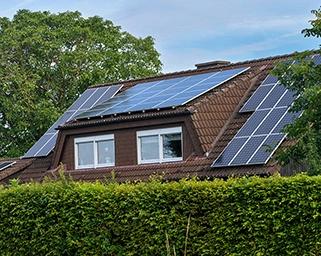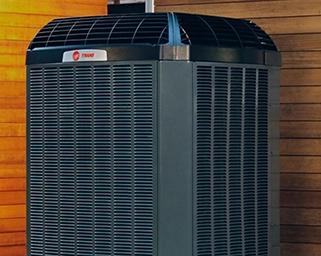How to Reduce Your Carbon Footprint
Discover how making home upgrades and changing the way you travel can greatly reduce your carbon footprint and help reduce the effects of climate change.
By Anne Fonda
At Trane, sustainability is at the heart of everything we do. That’s why we’ve committed to the Gigaton Challenge to help our residential and commercial customers reduce one billion metric tons of greenhouse gas emissions from their carbon footprints.
Customer use of our products is our most significant area of opportunity to reduce carbon emissions. By innovating and manufacturing highly energy-efficient and sustainable heating, cooling, and refrigeration solutions using next-generation refrigerants, we are well on our way to meeting the challenge.
What is a carbon footprint?
If you’re committed to living more sustainably, like we are, you may already know what a carbon footprint is. But for folks just starting to think about climate change, conserving energy, and possibly saving on your energy bills, a basic definition is this:
A carbon footprint is the amount of carbon dioxide, methane, and greenhouse gases you create going about your daily activities. A company, organization, product, or entire industry can also have a carbon footprint.
While we specialize in residential HVAC systems, we also recognize that there are many ways to reduce your carbon footprint. We’ve pulled together some of the top things you can do if you want to make an impact.

Start at home
The easiest place to start is at home. You have a lot of control over your energy usage, home systems, and habits. Remember, energy efficiency = energy savings = money saved.
Pay attention to lights and electrical plugs
These are easy things to do.
- Turn off the lights when you’re not in the room or when natural light is sufficient.
- Upgrade to LED lightbulbs. Some ENERGY STAR®-qualified bulbs can reduce your energy usage by 90% over standard bulbs, and they last longer, too.
- Unplug small kitchen appliances such as the coffeemaker and toaster when not in use.
- Use smart power strips for electronics and computers. They’re designed so the peripheral equipment such as the Xbox or computer monitor only comes on when the TV or computer is turned on.
Weatherize
Start with a home energy audit and follow the recommendations. Seal cracks and leaks around windows and doors. Consider adding more insulation to your attic, crawlspace, or garage. Sealing and insulating your home helps prevent energy loss.
If your energy audit includes a blower door test, especially after any air sealing measures (called a test out) save that information because it will be important for HVAC design or HVAC replacement.
Read our blog on weatherization for more information on what to do to increase your home’s energy efficiency.
Move to more sustainable heating and cooling
An oil or gas furnace or boiler that burns fossil fuels is a big contributor to your home’s carbon emissions and your carbon footprint. When it’s time for HVAC replacement, consider a furnace-to-heat pump conversion. Unlike a fuel-burning furnace or boiler, an electric heat pump does not produce any carbon emissions.
According to industry experts, 85% of homes in the U.S. can be cooled and heated by a heat pump alone. If you live in an area with harsh winters, consider a hybrid heating system where you pair the heat pump with a furnace. The heat pump heats most of the time and the furnace kicks in only when the heat pump becomes inefficient.
When purchasing an air source heat pump system, look for a heat pump with a high Seasonal Energy Efficiency Ratio (SEER2) for cooling efficiency and a high Heating Seasonal Performance Factor (HSPF2) for heating efficiency. Be sure to get a smart thermostat for optimal comfort and savings.
Certain energy-efficient systems qualify for rebates and federal tax credits such as the Energy Efficient Home Improvement tax credit.
Visit our Electrification Hub for more information on all-electric heat pump systems.
Consider home electrification
Home electrification takes things a step further. In addition to converting to an electric HVAC system, you replace gas appliances with energy-efficient electric models. For example, this can include replacing a gas stove, gas water heater, gas washer, and dryer. Electric models can be comparable in pricing and use less energy, potentially reducing your utility bills.

Consider green energy sources
If you’re really into sustainable living, you can look into powering your home with green energy. This could include installing solar panels on your roof or on your property, for example. There are tax credits available that can help you pay for this. If you use less energy than you use, you can sell that energy back to the grid in a process called net metering.
If solar panels aren’t an option, depending on your power company, you may be able to purchase renewable energy directly from them. In some states where the energy industry has been deregulated, you can choose who you buy power from.
This means you can buy solar or wind power from one company and your power distributor distributes it to your home. You get one bill from your power company. Pennsylvania is an example of this. They deregulated electricity in 1996 and provided the website papowerswitch.com for homeowners and businesses.
*Switching your home from oil, gas, or coal-powered energy to renewable sources of energy, such as wind or solar, can reduce your carbon footprint by up to 1.5 tons of CO2e per year.
Watch what you eat
Did you know that the types of food you eat can affect carbon emissions? Growing fruits and vegetables results in fewer greenhouse gas emissions and water usage than factory farms that house cattle, hogs, and chickens. In addition, according to the Environmental Protection Agency (EPA), composting fruit and vegetable scraps and plant matter can help "lower greenhouse gases by improving carbon sequestration in the soil and by preventing methane emissions through aerobic decomposition.”
*Transitioning to a plant-based diet can reduce your carbon footprint by up to 500 kilograms of CO2e per year (or up to 900 kilograms for a vegan diet).

Check your closet
The clothes you buy cause carbon emissions at each point in production, from the production of the raw materials to manufacturing to shipping and transportation. Avoid buying fast fashion and instead, look deep into your closet for a forgotten top or pair of pants. Shop consignment shops and thrift stores for new finds.
Buying fewer new clothes – and other consumer goods – can also reduce your carbon footprint. *Every kilogram of textiles produced generates about 17 kilograms of CO2e.

While at work
You can continue your efforts to reduce your overall carbon footprint while at work. This can help your employer or facilities manager meet their goals, as well. In addition to the habits you’ve developed at home, try these tips.
- Take the stairs if you are able. Elevators use energy.
- Avoid printing agendas or reports and send them out via email.
- Turn off your computer and peripherals at the end of the day.
While traveling
The most sustainable ways to travel or commute are by walking or riding a bike. Those modes of transportation are also great for exercise. Think twice about hopping in the car if it’s a short distance and a lovely day. For longer trips, consider these options to further reduce your carbon footprint.

Upgrade to a hybrid or electric car
The next time you need to buy a car, include hybrid and electric options in your list of possibilities. By purchasing one of these options, you’ll save on gas and reduce carbon emissions.
If you purchase a new electric vehicle (EV) you may qualify for a federal tax credit. You may also qualify for an additional tax credit to help you install an EV charger in your garage. Visit the Alternative Fuels Data Center, a division of the Department of Energy (DOE) for details.
*Switching from a gasoline-powered car to an electric vehicle can reduce your carbon footprint by up to 2 tons of CO2e per year. A hybrid vehicle can reduce it up to 700 kilograms of CO2e per year.
Use public transportation when possible
If you’re fortunate enough to live in an area with reliable public transportation such as city and regional buses or trains, take advantage of it. Consider carpooling to work if you live in a more suburban or rural area.
*Living without a car can reduce your carbon footprint by up to 2 tons of CO2e per year compared to using a car every day.
*Figures on how much an action can reduce your carbon footprint come from The United Nations.
Reduce air travel
Sometimes you have to travel by plane for work or personal reasons. If you must fly, book direct flights. If you have the time and it’s feasible, take the train to your destination. According to the DOE, on average, Amtrak travel is 34% more energy-efficient per passenger than air travel.
Use a carbon footprint calculator
Interested in learning about the size of your carbon footprint? Use the Nature Conservancy’s carbon footprint calculator. To calculate your carbon footprint most accurately, you may want to access your monthly utility bills as well as credit card statements to enter precise figures.
The average American’s carbon footprint is 16 tons – four times the global average. By making some small changes, you can make an impact on our future and on your wallet.
Work with the HVAC sustainability experts
If you’re in the market for a new HVAC system that can help you save energy, save money, and reduce carbon emissions at the same time, reach out to your local Trane dealer. They can help you compare systems to find the one that is right for you and your goals. Be sure to ask about heat pump tax credits and heat pump rebates under the Inflation Reduction Act of 2022.
Anne Fonda, Content Writer
A Content Writer with Trane Technologies, Anne Fonda researches topics and writes for Trane® and associated residential HVAC brands. She works in collaboration with Trane Technologies subject matter experts, offering easy-to-understand, informative content on complex topics. Her goal is to help consumers make informed decisions on the products and services they need.
She has written for HVAC and other service provider websites for over 16 years. Before transitioning to web content writing, Anne had a 14-year stint as an award-winning journalist. She graduated cum laude from the University of Missouri-Columbia School of Journalism.
When she’s not working, Anne enjoys playing word games, reading, gardening, spending time with family, and visiting gardens and museums.
Expert review by Stacy Downie, Sustainability Solutions Marketing Manager and Josef Hejda, Electrification Commercialization Leader




